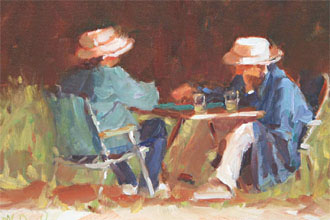|
| Magriel's NYT Columns |
 Backgammon strategy continues to evolve as new players enter the game and new theories are tested. The traditional approach to the game emphasized a safe, conservative style of play directed toward the running game.
Backgammon strategy continues to evolve as new players enter the game and new theories are tested. The traditional approach to the game emphasized a safe, conservative style of play directed toward the running game.
In the late 1960’s, a new style of play was introduced that radically altered the nature of the game. This style emphasized playing “wide open,” frequently leaving blots (exposed men) in order to rapidly bring men into play.
As a result, more complicated games developed, with many men being sent back on each side. In the last year or two a new trend has emerged among some of the better young players. They have adopted a more “structural” approach — that is, making and holding key points to build solid formations. In general, they stress long-term positional gains over immediate tactical advantages.
In the diagrammed position, Black has just doubled and has a superior position. He has already sent a third man of White’s back; he has a stronger home board and a more flexible distribution of men.
|
| Black to play 6-1. |
The first inclination is to hit White by playing 24/17*, sending yet another man back. Although hitting puts White further behind in the race, it does not accomplish anything of concrete value.
In fact, the fourth man back actually gives White greater potential for mischief. This extra man gives White the beginnings of a back game. (White must hold at least two points deep within Black’s home board). Also, it gives White several opportunities to make the 5-point and so establish a viable holding game.
The correct play is 11/5, 6/5, making the 5-point. With this move, Black greatly strengthens his home position. Indeed, the 5-point is considered the most valuable point to make in the home board. In conjunction with the 4-point, Black has created a structure that will give him a lasting advantage.
This play keeps Black’s options open. He may attack White in his home board, play a priming game by making the 7-point, or even simply escape with his back man and come home. In any case, White’s chances of making a comeback are diminished because he will always have to face Black’s solid formation.
Rollout
 Tom Keith 2013 |
|
Money play White owns 2-cube Black rolls 6-1 1296 games with VR Checker play: 2-ply Cube play: 3-ply Red |
| 6-1: | Game | G | BG | Equity | ||||
| 1 | 11/5, 6/5 |
W L |
.6760 .3240 |
.2629 .0774 |
.0243 .0036 | +0.4326 |

| (b) |
| 2 | 24/17* |
W L |
.6543 .3457 |
.2548 .0697 |
.0250 .0028 | +0.3802 | (0.0524) | (a) |

|
|

